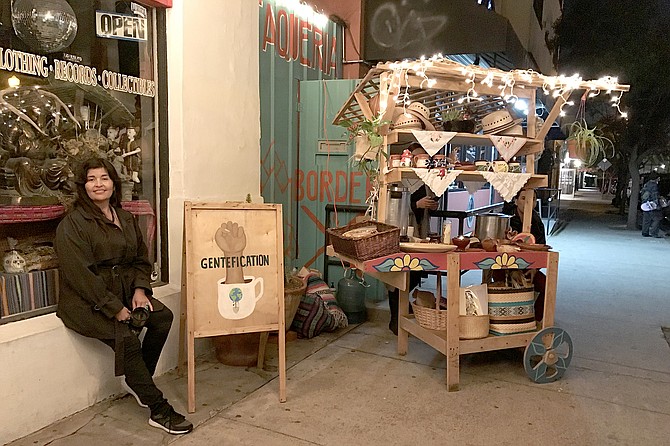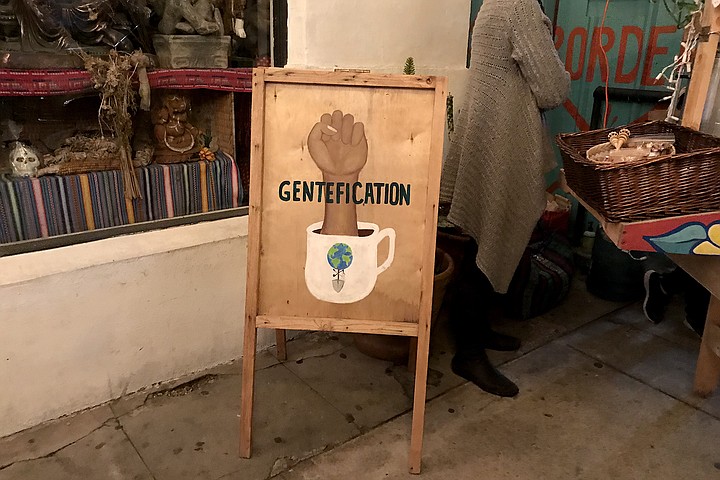 Facebook
Facebook
 X
X
 Instagram
Instagram
 TikTok
TikTok
 Youtube
Youtube

Next month, April 25, Barrio Logan will be celebrating the 50th anniversary of the birth of Chicano Park. And the surprise question? Is success bringing about the demise of this most culturally cohesive neighborhood?
It’s eight o’clock on a Thursday night. I’m here on Logan Avenue. Latin jazz flares out of Border X, at Logan and Sampson. Janice Luna Reynoso and her friend Paulina Jimenez stand by a “coffee and culture” cart business they have named “Gentefication.”
They sell Mexican items such as bundles of sage, hats, and steaming hot cups of cafe de la olla.
“The name? To make people uncomfortable,” says Luna. She says gentrification is nibbling into Barrio Logan’s marrow, and she’s desperately looking for a way to change the trajectory. “That’s really why we created this cart, to draw people into conversations about gentrification.” She’s ready to argue the point with anyone while she hands out her delicious cinnamon coffee.

Luna has deep roots in the area. She runs community gardens in National City and elsewhere. “Gentrification can be looked at in two different ways. Like me: I’m an artist, an entrepreneur. Brown folks like myself are San Diegans who have grown up in the different barrios. Yet we in a sense have contributed to the issue of gentrification. Because we have opened stores, we’re selling the goods that are recognized as coming from our culture. Our culture is very beloved in the community and it attracts outsiders to the barrio. We also have to take the responsibility of owning our own businesses. We’re adding to the increase in property values. People say, ‘Oh you’re a gentrifier. You’re actually from here but you’re creating a problem.’”
She says she’s working hard to give back, and somehow mitigate the effects of their success. “Yes, we’re gentrifiers, because we want to see our community thrive, we’re artists, we’re entrepreneurs, but we want gentrification, change, to take more of a positive role. Because when we say gente, in our community, ‘Eres bien gente,’ it’s like ‘You’re really good people.’ These are the people, the pueblo. We want to go back to that root word. It’s about building capital, but community capital, rather than financial capital.”

Luna knows the effects of gentrification. “I’ve been displaced a couple of times with my three daughters. From Golden Hill, and National City as well, and we ended up house-surfing because of rent hikes. Rent went up because of gentrification, so I’m passionate about that. Even a safe space like Chicano Art Gallery was pushed out last year. When people from outside the barrio come for coffee, and they see our ‘Gentefication’ sign, it’s that uncomfortable silence for a moment, and then it’s either awkward and ‘thank you,’ and then they take their coffee and leave a good tip, or some say ‘Thank you for talking about this with us.’ So it has been a mixed response. More the awkward glance and discomfort, but I’m okay with that. At least we’re having this conversation.
Does she believe the real Barrio Logan will survive? “I have to believe that we’re making a change, inspired by the leaders who brought Chicano Park into being 50 years ago, who fought for civil rights before us. I’m an artist, and we’re using what we call ‘Artivism,’ art to activate people’s hearts.”


Next month, April 25, Barrio Logan will be celebrating the 50th anniversary of the birth of Chicano Park. And the surprise question? Is success bringing about the demise of this most culturally cohesive neighborhood?
It’s eight o’clock on a Thursday night. I’m here on Logan Avenue. Latin jazz flares out of Border X, at Logan and Sampson. Janice Luna Reynoso and her friend Paulina Jimenez stand by a “coffee and culture” cart business they have named “Gentefication.”
They sell Mexican items such as bundles of sage, hats, and steaming hot cups of cafe de la olla.
“The name? To make people uncomfortable,” says Luna. She says gentrification is nibbling into Barrio Logan’s marrow, and she’s desperately looking for a way to change the trajectory. “That’s really why we created this cart, to draw people into conversations about gentrification.” She’s ready to argue the point with anyone while she hands out her delicious cinnamon coffee.

Luna has deep roots in the area. She runs community gardens in National City and elsewhere. “Gentrification can be looked at in two different ways. Like me: I’m an artist, an entrepreneur. Brown folks like myself are San Diegans who have grown up in the different barrios. Yet we in a sense have contributed to the issue of gentrification. Because we have opened stores, we’re selling the goods that are recognized as coming from our culture. Our culture is very beloved in the community and it attracts outsiders to the barrio. We also have to take the responsibility of owning our own businesses. We’re adding to the increase in property values. People say, ‘Oh you’re a gentrifier. You’re actually from here but you’re creating a problem.’”
She says she’s working hard to give back, and somehow mitigate the effects of their success. “Yes, we’re gentrifiers, because we want to see our community thrive, we’re artists, we’re entrepreneurs, but we want gentrification, change, to take more of a positive role. Because when we say gente, in our community, ‘Eres bien gente,’ it’s like ‘You’re really good people.’ These are the people, the pueblo. We want to go back to that root word. It’s about building capital, but community capital, rather than financial capital.”

Luna knows the effects of gentrification. “I’ve been displaced a couple of times with my three daughters. From Golden Hill, and National City as well, and we ended up house-surfing because of rent hikes. Rent went up because of gentrification, so I’m passionate about that. Even a safe space like Chicano Art Gallery was pushed out last year. When people from outside the barrio come for coffee, and they see our ‘Gentefication’ sign, it’s that uncomfortable silence for a moment, and then it’s either awkward and ‘thank you,’ and then they take their coffee and leave a good tip, or some say ‘Thank you for talking about this with us.’ So it has been a mixed response. More the awkward glance and discomfort, but I’m okay with that. At least we’re having this conversation.
Does she believe the real Barrio Logan will survive? “I have to believe that we’re making a change, inspired by the leaders who brought Chicano Park into being 50 years ago, who fought for civil rights before us. I’m an artist, and we’re using what we call ‘Artivism,’ art to activate people’s hearts.”
Comments